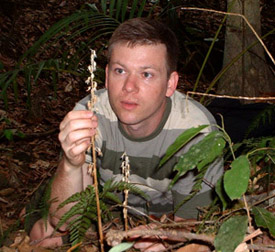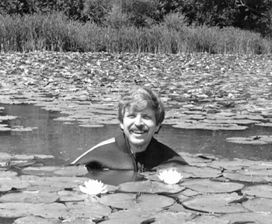Principal Investigators

As molecular tools gain power and costs drop, sequence databases swell, enhancing our ability to construct phylogenies and understand how genes and lineages diversify. Flow cytometry gives us rapid estimates of overall genome size. Surveys of genetic variation within and among populations let us characterize gene flow, population differentiation, and genetic threats to persistence. We can track how traits originate and diverge across lineages and how these affect species sorting into ecological communities along environmental gradients. We now partition community structure into stochastic and deterministic components related to lineages and traits. Ecologists track how species and communities respond to habitat loss and fragmentation, invasive species, disrupted trophic interactions, and climate change. Across these fields, new analytical tools and expanding databases enhance our opportunities to compare, analyze, and synthesize these results.
We, and our collaborators, use all these approaches to understand phylogenetic, genetic, and ecological patterns of diversity. However, we have tended to work along parallel paths, as systematists deriving phylogenies, geneticists quantifying heritable variation, and ecologists studying processes, traits, and ecosystems. All these are worthwhile, but we are now eager to work as a team to address a deeper set of questions. This is a special time in the development of our fields, in terms of the tools available to generate and analyze data in more integrated ways. We focus on studying the dynamics of biodiversity affected by environmental change, supported by unique historic and contemporary data sets now becoming available. Our professional interests and career trajectories are converging as we see this special opportunity to combine our talents and data to achieve greater syntheses than we could alone.
My primary research interests focus on the systematics, evolution, structure, and conservation of orchids (Orchidaceae) based on studies carried out in the field, herbarium, library, and laboratory. Collaborating with an international group of scientists and students, I continue to use gene sequence data to reconstruct the phylogenetic history of orchids with the ultimate goal of producing a robust and stable system of classification for this diverse and charismatic family. My work has contributed extensively to our knowledge of the anatomy, life history, ecology, physiology, and evolution of Orchidaceae, but I consider myself a specialist, in particular, on the orchid subfamily Vanilloideae. This ancient clade includes the only orchid of agricultural value, Vanilla, and is pivitol to the study of orchid evolution since several taxa are partially or fully mycoheterotrophic and can no longer photosynthesize on their own.
In addition to orchids, I have published studies on the systematics, biogeography, character evolution, and classification of other equally fascinating plant groups such as Smilacaceae, Malpighiaceae, Cactaceae, Droseraceae, and Lentibulariaceae. My fieldwork has taken me from Mexico to Ecuador, from Tasmania to Borneo, and from China to New Caledonia, but some of the most memorable plant collecting trips have taken place right here in the United States. I am passionate about all aspects of plant biology, and eager to share that passion with fellow scientists, students, and the public alike.
Dr. Waller is an ecologist in the Department of Botany at the University of Wisconsin-Madison who teaches courses in ecology, evolution, and conservation biology. His research focuses on threats to plant and animal diversity, the impacts of deer browsing and invasive species, and the fate of small populations. His research in evolutionary biology and population genetics focuses on the evolution of mating systems and the genetic threat of inbreeding. He works with environmental organizations, land trusts, and state and federal resource agencies and scientists to inject science more effectively into forest and game management. He co-authored Wild Forests: Conservation Biology and Public Policy (Island Press 1994), co-edited The Vanishing Present: Shifts in Wisconsin’s lands, waters, and wildlife (Univ. of Chicago Press 2008), and has authored or co- authored over 100 journal articles. He is a Fellow of the American Association for the Advancement of Science, a former Editor-in-Chief of the journal Evolution and former President of the Society for the Study of Evolution.
Our research centers on questions of plant diversity - how are species and higher clades related? How should these taxa be classified? What are the processes that have influenced their origins? How have key morphological characters evolved? Do morphological and ecological features show convergence among unrelated taxa, or divergence within related taxa? What is the temporal setting for these diversifications?
These questions are addressed on taxa from species to orders, and across temperate and tropical biomes. Molecular phylogenetics (DNA sequencing) is the primary way that phylogenetic frameworks are obtained to address these questions.
My students and I explore several questions involving the interface of ecology, evolution, systematics, and biogeography:
What are the historical processes by which plant species arise, diverge ecologically, and come to occupy different habitats and geographic regions?
How do various features of plant form, physiology, and behavior affect energy capture and growth under different conditions, and thereby result in competitive success in some contexts and not others?
How can adaptations constrain species distributions and help create gradients in the composition, structure, and diversity of communities and landscapes?
What are the roles of spatially coupled, positive and negative feedbacks in creating patterned landscapes, and how might these be important in designing conservation and restoration strategies at large spatial scales?
Our research involves a wide range of terrestrial, wetland, and aquatic systems, and monocot and dicot lineages around the world. Current projects focus on the following topics:
Adaptive radiation
Phylogeography
Physiological ecology
Conservation biology
Monocot AToL



